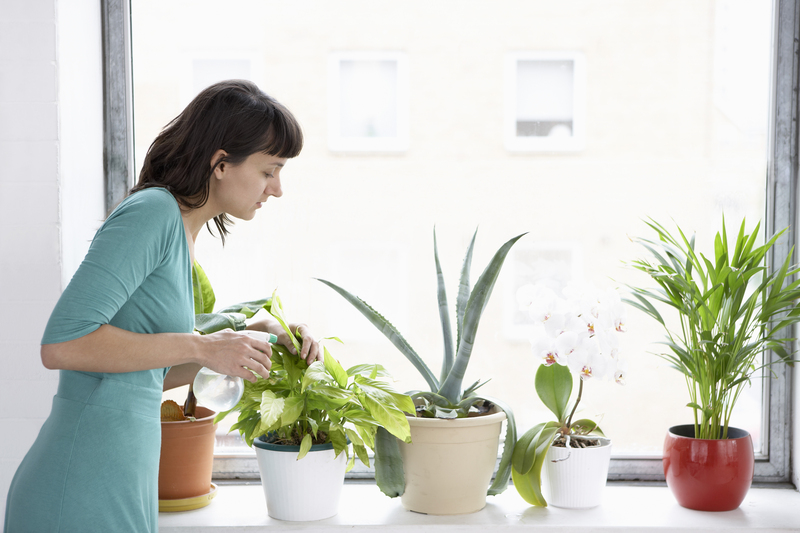Inventive Child-Friendly Gardening Solutions
Posted on 17/06/2025
Inventive Child-Friendly Gardening Solutions: Making Gardening Magical for Kids
Gardening isn't just for adults--it's a world of discovery for children, too! With the right child-friendly gardening solutions, you can transform any outdoor or indoor space into an engaging playground for curious minds. In this article, we will delve deeply into creative and safe gardening ideas that spark imagination and instill in children a lifelong love for nature. Whether you have acres of land or just a sunny windowsill, you'll find inventive options tailored for every little gardener.

Why Encourage Children to Garden?
Introducing children to gardening offers a multitude of developmental, educational, and emotional benefits. Here are just a few reasons why child-friendly gardening projects matter:
- Educational Growth: Learning about plant life cycles, biology, and nutrition.
- Physical Activity: Digging, watering, and planting promote gross and fine motor skills.
- Sensory Development: Feeling different textures, smelling flowers, and tasting edible plants.
- Emotional Well-being: Gardening is proven to reduce stress and boost confidence in kids.
- Connection to Nature: Instills respect for the environment from a young age.
Features of Safe & Inviting Child-Oriented Gardens
Creating a garden space specifically for children requires some forethought. Here are critical features to consider when developing inventive gardening ideas for kids:
- Non-Toxic Plants: Avoid toxic or spiny plants; choose herbs, edible flowers, and vegetables.
- Soft Edges: Rounded edges on garden beds, stepping stones, and fencing help prevent injuries.
- Accessible Layout: Raised beds and vertical gardens at child height make reaching and tending easy.
- Colorful and Engaging: Paint garden containers bright colors and use whimsical decorations.
- Interactive Elements: Add fairy doors, bug hotels, and water features for multi-sensory play.
Top Inventive Child-Friendly Gardening Solutions
1. Sensory Garden Plots
A sensory garden is a specially designed space that stimulates all five senses. These miniature gardens bring child-friendly gardening to a new level, allowing kids to touch soft lamb's ear, smell fragrant lavender, listen to rustling grasses, see vibrant flowers, and taste sweet strawberries--all within arm's reach!
- Touch: Lamb's ear, moss, bunny tail grass
- Smell: Mint, basil, lemon balm, lavender
- See: Marigolds, pansies, sunflowers
- Hear: Wind chimes, ornamental grasses
- Taste: Cherry tomatoes, sugar snap peas, strawberries
2. Edible Play Gardens
Transform garden beds into a living salad bowl! Kids can plant, tend, and nibble on organic vegetables and fruits. Edible landscaping not only teaches invaluable lessons about food sources but also encourages healthy snacking habits.
- Choose quick-growing crops like radishes, lettuce, and cherry tomatoes.
- Use raised beds or container gardens for easy access and maintenance.
- Label each plant with fun homemade signs to boost early literacy skills.
3. DIY Fairy and Dinosaur Gardens
Let imaginations run wild with mini fairy gardens or dinosaur habitats. These themed container gardens offer creative outlets and attract pollinators. Use tiny figurines, pebbles, and moss to make a mystical landscape right on your patio or windowsill.
- For a fairy garden: Add miniature houses, bridges, and fairy figurines.
- Dinosaur gardens can feature toy dinosaurs, rocks, and ferns to mimic prehistoric habitats.
- Encourage story-telling and imaginative play alongside botanical science.
4. Waterwise Gardens with Kids
Teaching children about water conservation can be both instructive and fun. Succulent gardens or xeriscape plots use drought-tolerant plants and creative mulching techniques. Incorporate colorful stones or sand to craft patterns and paths.
- Opt for succulents, sedum, or ornamental grasses.
- Involve kids in collecting rainwater in barrels for watering.
- Create pebble mosaics or painted rock borders for extra flair.
Fun and Easy DIY Child Gardening Projects
You don't need an expansive garden to foster a love for plants. These child gardening projects are approachable for all skill levels and space constraints.
Grow-Your-Own Pizza Garden
Imagine picking fresh basil leaves or tomatoes for your homemade pizza! Dedicate a small patch or large container to classic pizza ingredients for a themed garden adventure.
- Tomatoes, bell peppers, basil, oregano, and onions are must-haves.
- Plant in a circular "pizza slice" pattern for extra fun.
- Let kids harvest and help prepare their own pizza toppings.
Egg Carton Sprout Lab
Start seeds indoors or outside using upcycled egg cartons. Egg carton gardens are mess-free and child-sized.
- Let children fill each cell with potting soil and seeds.
- Track growth with a daily journal or chart.
- Transplant sprouts to the garden when strong enough.
Bug Hotel Construction
Encourage children to learn about ecosystems with a DIY bug hotel! Recycle bamboo tubes, pinecones, straw, and sticks in a wooden frame. Hang your creation in the garden to welcome bees, ladybugs, and butterflies.
- Observe insects and discuss their important role in pollination.
- Add a magnifying glass and nature journal for scientific exploration.
Creating Safe, Engaging Play Areas in the Garden
Safety is paramount in gardening for children. Here's how to zone your garden for fun while minimizing hazards:
- Secure Boundaries: Use low, soft fencing or raised beds to define play areas and keep children safe from garden tools or chemicals.
- Tool Corner: Supply kids with age-appropriate gardening tools--think plastic trowels, gloves, and watering cans.
- Shady Rest Zones: Provide benches or picnic blankets under trees for rest and story time.
- Keep Pathways Clear: Gravel, mulch, or stepping stones lead little feet safely from one garden zone to another.
The Best Plants for Child-Friendly Gardening Spaces
Plant selection is key to a successful children's garden. Look for soft, resilient, and low-maintenance species. Here are top picks for kid-friendly gardening:
- Sunflowers: Fast-growing and dramatic--kids can measure and compete to see whose is tallest.
- Snapdragons: Vibrant colors and "talking" flowers (squeeze gently for fun!).
- Peas and Beans: Easy to sprout, fun to pick and eat.
- Herbs: Mint, chives, basil, and oregano for sensory delight.
- Strawberries: Sweet, safe snacking straight from the plant.
- Nasturtiums: Peppery, edible flowers that deter pests and brighten beds.
Inventive Indoor Gardening Activities for Kids
Apartment dwellers and city families needn't miss out on child-friendly gardening. Indoor gardening can be just as rewarding--and impressively inventive!
1. Windowsill Herb Gardens
Grow compact herbs like basil, parsley, and thyme in colorful recycled containers on your sunniest ledge. Let children snip herbs to flavor meals.
2. Hydroponic Jar Gardens
Mason jars filled with water and plant cuttings let kids observe roots growing in real time. Try green onions, sweet potato vines, or pothos. (Use labels to add science vocabulary learning!)
3. Microgreen Farms
Fast-growing microgreens (like radish, cress, or arugula) germinate on damp paper towels or spread in shallow trays. Children see results in days, boosting engagement.
Making Gardening Year-Round: Seasonal Inspiration
Children's gardening success shouldn't end when the weather changes. Here are all-season kid gardening solutions:
- Spring: Sow seeds indoors or start cool-weather plants outside.
- Summer: Harvest vegetables, cut flowers, and enjoy garden picnics.
- Fall: Collect leaves, plant bulbs for spring, make compost.
- Winter: Decorate potted evergreens, grow winter greens inside, or craft bird feeders for garden wildlife.
Encouraging Curiosity: Journals, Crafts, and Science in the Garden
Maximize the learning potential of your child's garden by integrating crafts, observation, and science:
- Garden Journaling: Record plant growth, weather patterns, and wildlife sightings. Drawing and writing together boosts both literacy and observation skills.
- Nature Crafts: Make leaf prints, flower crowns, or plant-based art projects from natural materials found in the garden.
- Simple Experiments: Compare growth rates of plants with different amounts of sunlight or water. Start a worm compost bin to observe decomposition.

Tips for a Successful & Inclusive Child Gardening Experience
Whatever inventive child-friendly gardening solution you choose, remember these tips to keep the experience accessible and fun:
- Start Small: Don't overwhelm your child--one raised bed or a few containers is plenty to begin with.
- Let Kids Take the Lead: Allow children to choose seeds, make planting decisions, and tend their gardens with minimal interference.
- Be Patient and Encouraging: Celebrate small successes and frame any "failures" as learning opportunities.
- Garden Together: Make gardening a family activity; collaboration enhances enjoyment and teaches teamwork.
- Include All Ages and Abilities: Vary the tasks so everyone can help, whether it's watering, labeling, or harvesting. Raised beds or tabletop gardens make participation easier for children with limited mobility.
Conclusion: Growing Young Gardeners with Innovative Solutions
Incorporating inventive child-friendly gardening solutions into your home or community space is one of the best ways to spark curiosity, creativity, and a lifelong love of nature in children. Whether you choose a whimsical fairy garden, a tasty edible plot, or a sensory oasis, the benefits extend far beyond pretty plants--they nurture healthy, engaged, and environmentally conscious future generations.
Start small, embrace the mess, and, most importantly, enjoy the magic of growing together.

